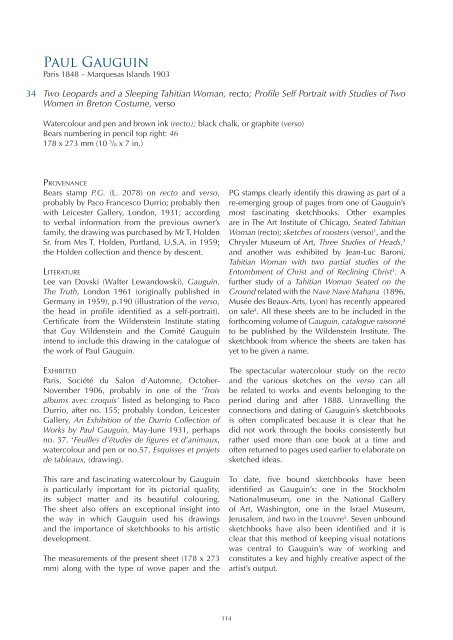XV - Works On Paper - Marty de Cambiaire (English)
Create successful ePaper yourself
Turn your PDF publications into a flip-book with our unique Google optimized e-Paper software.
Paul Gauguin<br />
Paris 1848 – Marquesas Islands 1903<br />
34<br />
Two Leopards and a Sleeping Tahitian Woman, recto; Profile Self Portrait with Studies of Two<br />
Women in Breton Costume, verso<br />
Watercolour and pen and brown ink (recto); black chalk, or graphite (verso)<br />
Bears numbering in pencil top right: 46<br />
178 x 273 mm (10 5 /8 x 7 in.)<br />
PROVENANCE<br />
Bears stamp P.G. (L. 2078) on recto and verso,<br />
probably by Paco Francesco Durrio; probably then<br />
with Leicester Gallery, London, 1931; according<br />
to verbal information from the previous owner’s<br />
family, the drawing was purchased by Mr T. Hol<strong>de</strong>n<br />
Sr. from Mrs T. Hol<strong>de</strong>n, Portland, U.S.A. in 1959;<br />
the Hol<strong>de</strong>n collection and thence by <strong>de</strong>scent.<br />
LITERATURE<br />
Lee van Dovski (Walter Lewandowski), Gauguin.<br />
The Truth, London 1961 (originally published in<br />
Germany in 1959), p.190 (illustration of the verso,<br />
the head in profile i<strong>de</strong>ntified as a self-portrait).<br />
Certificate from the Wil<strong>de</strong>nstein Institute stating<br />
that Guy Wil<strong>de</strong>nstein and the Comité Gauguin<br />
intend to inclu<strong>de</strong> this drawing in the catalogue of<br />
the work of Paul Gauguin.<br />
EXHIBITED<br />
Paris, Société du Salon d’Automne, October-<br />
November 1906, probably in one of the ‘Trois<br />
albums avec croquis’ listed as belonging to Paco<br />
Durrio, after no. 155; probably London, Leicester<br />
Gallery, An Exhibition of the Durrio Collection of<br />
<strong>Works</strong> by Paul Gauguin, May-June 1931, perhaps<br />
no. 37. ‘Feuilles d’étu<strong>de</strong>s <strong>de</strong> figures et d’animaux,<br />
watercolour and pen or no.57, Esquisses et projets<br />
<strong>de</strong> tableaux, (drawing).<br />
This rare and fascinating watercolour by Gauguin<br />
is particularly important for its pictorial quality,<br />
its subject matter and its beautiful colouring.<br />
The sheet also offers an exceptional insight into<br />
the way in which Gauguin used his drawings<br />
and the importance of sketchbooks to his artistic<br />
<strong>de</strong>velopment.<br />
The measurements of the present sheet (178 x 273<br />
mm) along with the type of wove paper and the<br />
PG stamps clearly i<strong>de</strong>ntify this drawing as part of a<br />
re-emerging group of pages from one of Gauguin’s<br />
most fascinating sketchbooks. Other examples<br />
are in The Art Institute of Chicago, Seated Tahitian<br />
Woman (recto); sketches of roosters (verso) 1 , and the<br />
Chrysler Museum of Art, Three Studies of Heads, 2<br />
and another was exhibited by Jean-Luc Baroni,<br />
Tahitian Woman with two partial studies of the<br />
Entombment of Christ and of Reclining Christ 3 . A<br />
further study of a Tahitian Woman Seated on the<br />
Ground related with the Nave Nave Mahana (1896,<br />
Musée <strong>de</strong>s Beaux-Arts, Lyon) has recently appeared<br />
on sale 4 . All these sheets are to be inclu<strong>de</strong>d in the<br />
forthcoming volume of Gauguin, catalogue raisonné<br />
to be published by the Wil<strong>de</strong>nstein Institute. The<br />
sketchbook from whence the sheets are taken has<br />
yet to be given a name.<br />
The spectacular watercolour study on the recto<br />
and the various sketches on the verso can all<br />
be related to works and events belonging to the<br />
period during and after 1888. Unravelling the<br />
connections and dating of Gauguin’s sketchbooks<br />
is often complicated because it is clear that he<br />
did not work through the books consistently but<br />
rather used more than one book at a time and<br />
often returned to pages used earlier to elaborate on<br />
sketched i<strong>de</strong>as.<br />
To date, five bound sketchbooks have been<br />
i<strong>de</strong>ntified as Gauguin’s: one in the Stockholm<br />
Nationalmuseum, one in the National Gallery<br />
of Art, Washington, one in the Israel Museum,<br />
Jerusalem, and two in the Louvre 5 . Seven unbound<br />
sketchbooks have also been i<strong>de</strong>ntified and it is<br />
clear that this method of keeping visual notations<br />
was central to Gauguin’s way of working and<br />
constitutes a key and highly creative aspect of the<br />
artist’s output.<br />
114
















